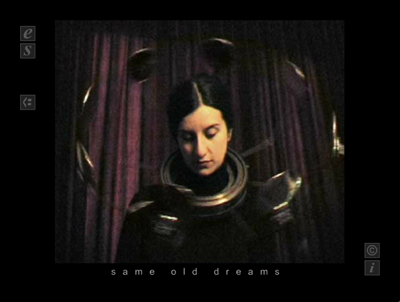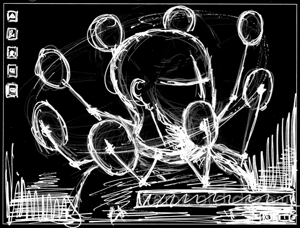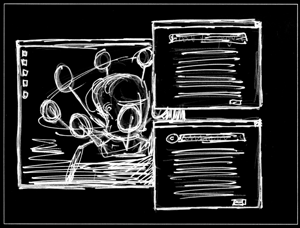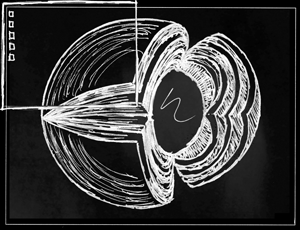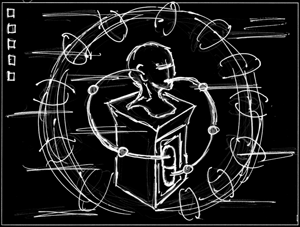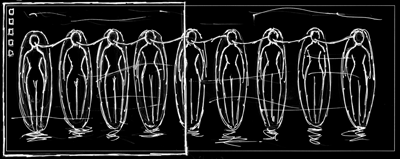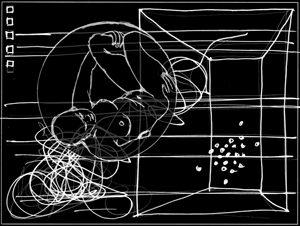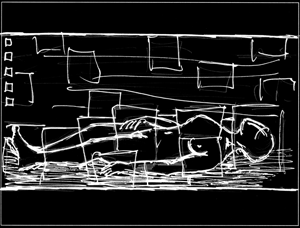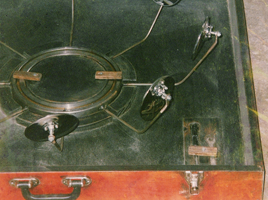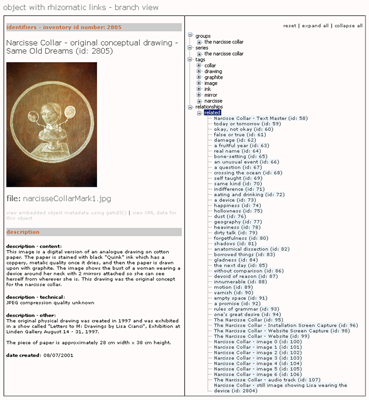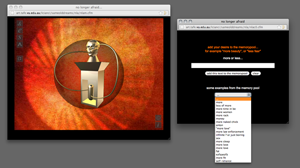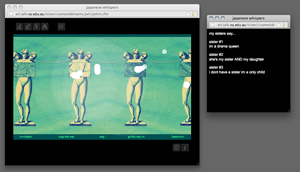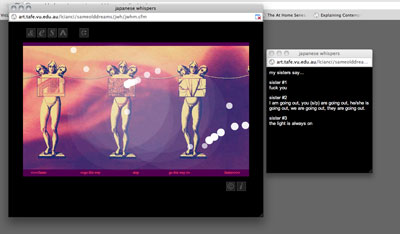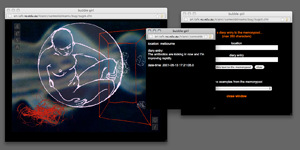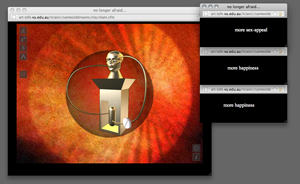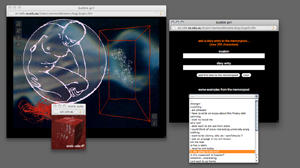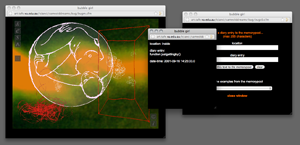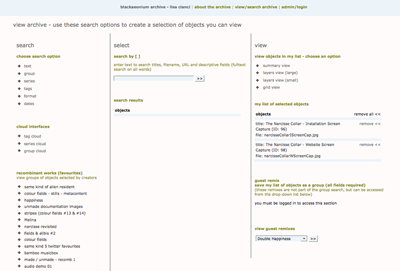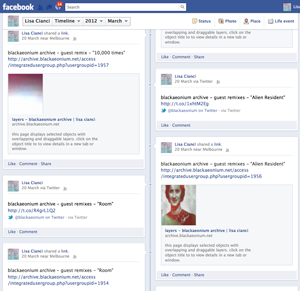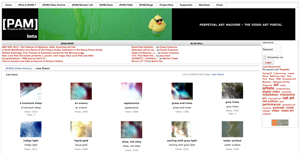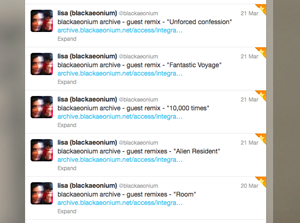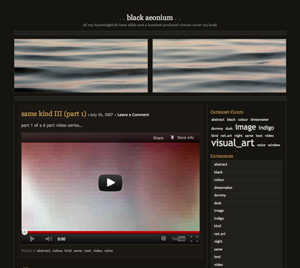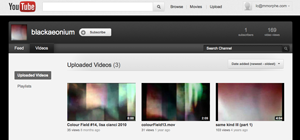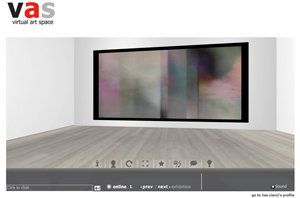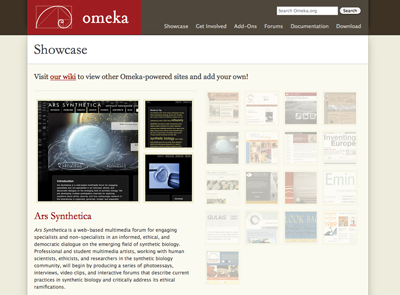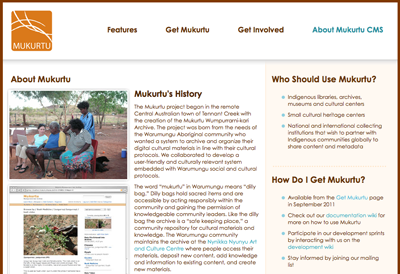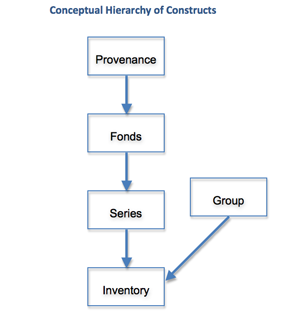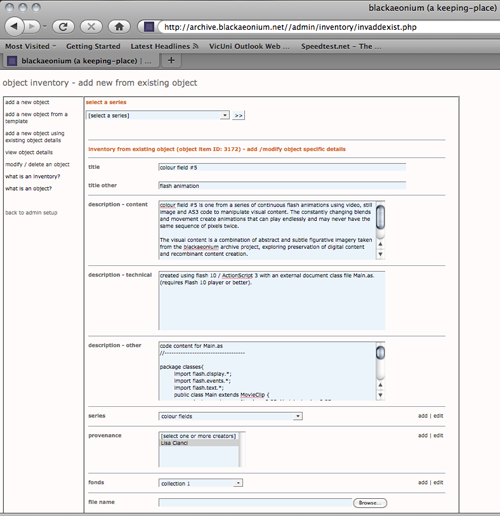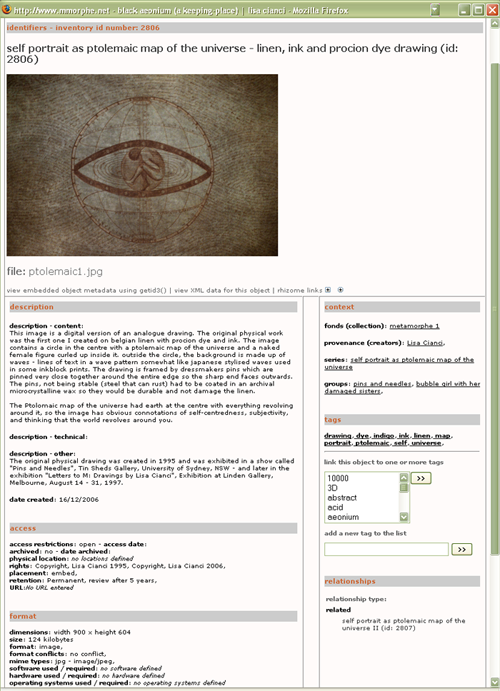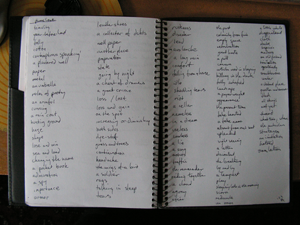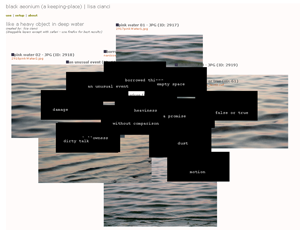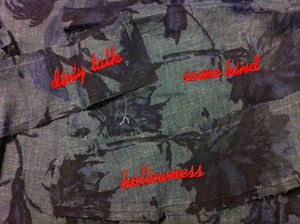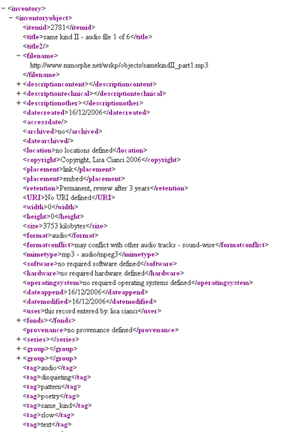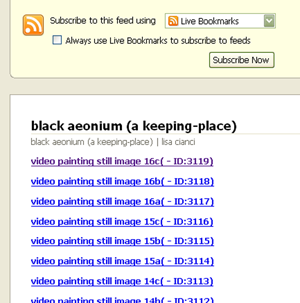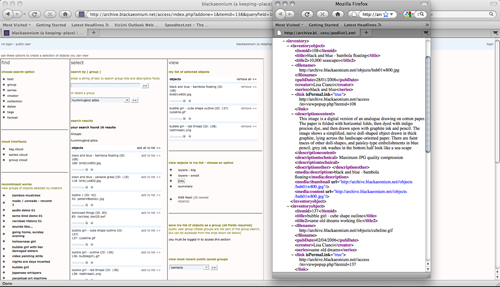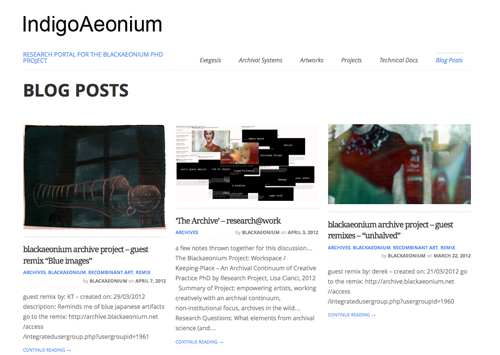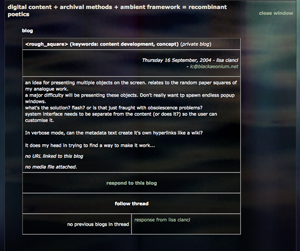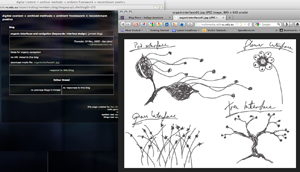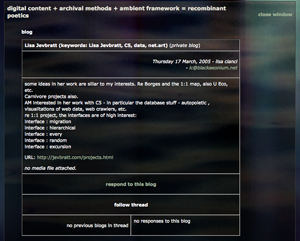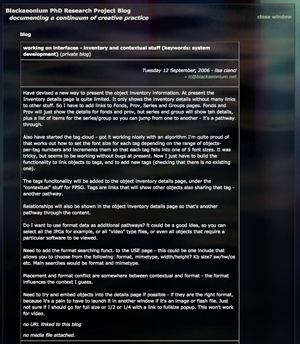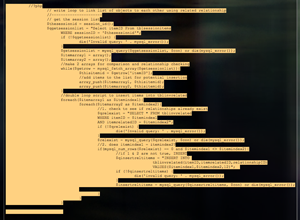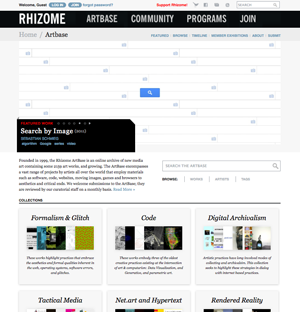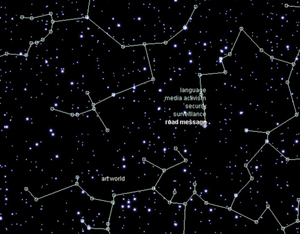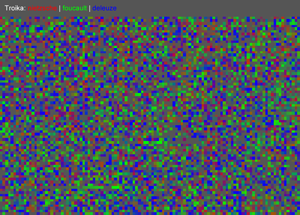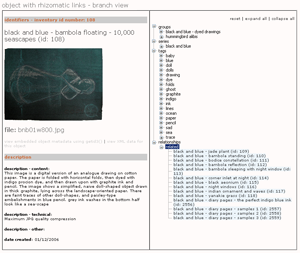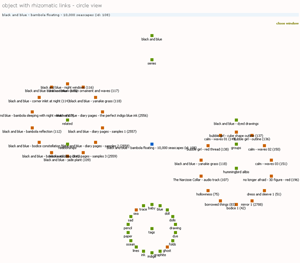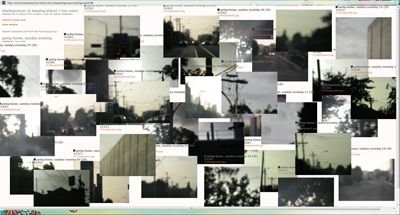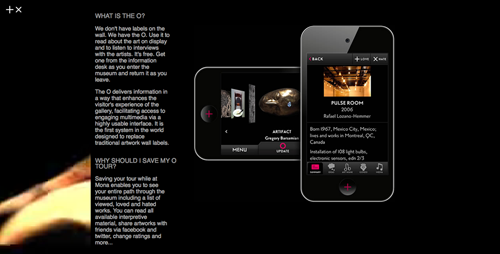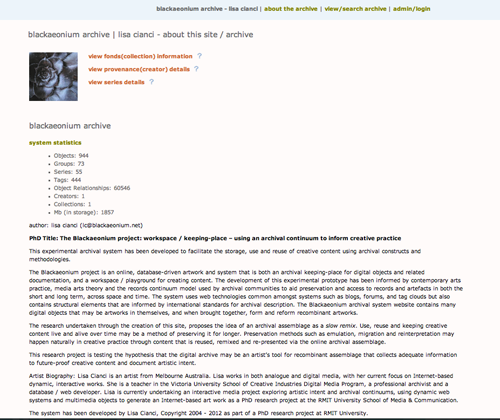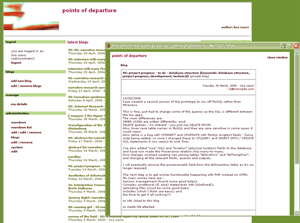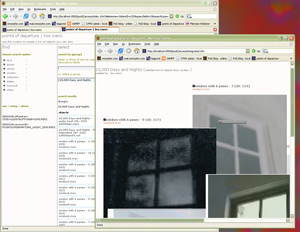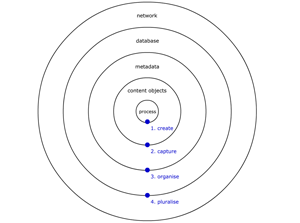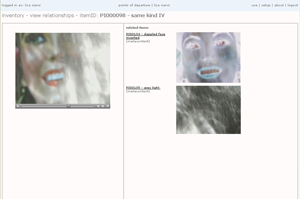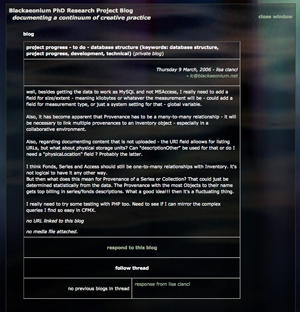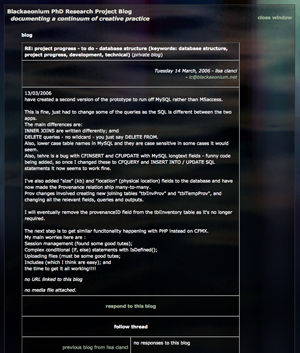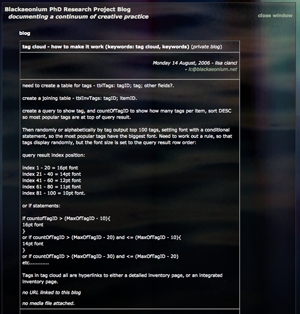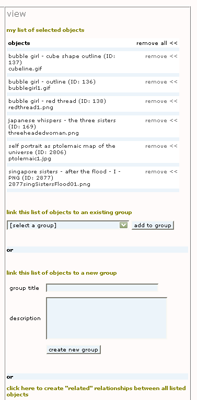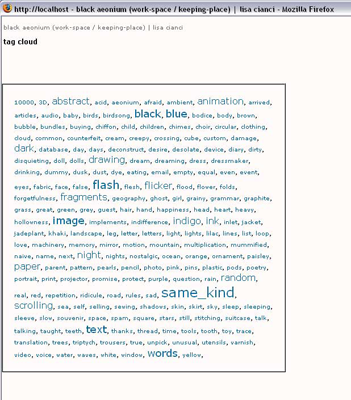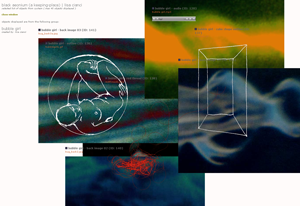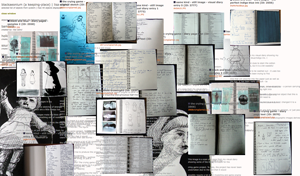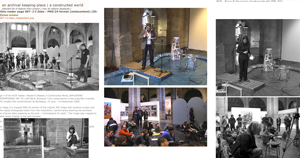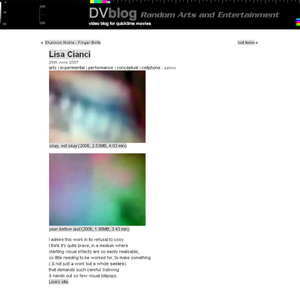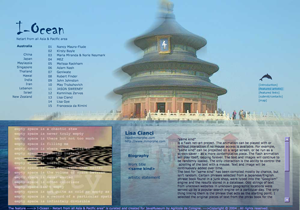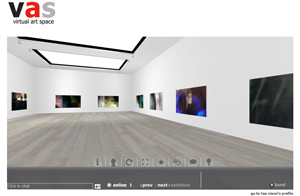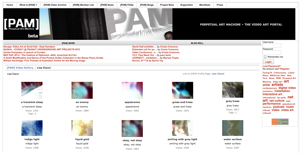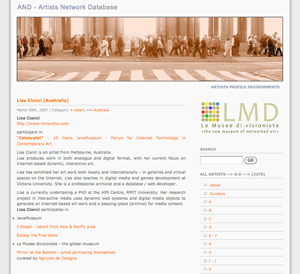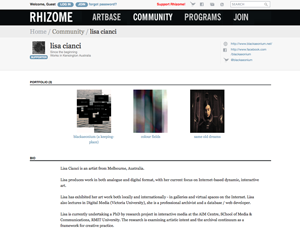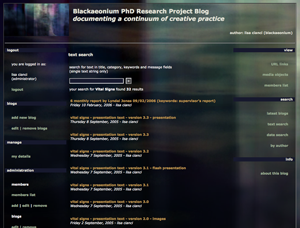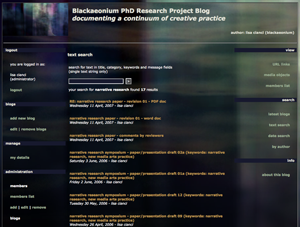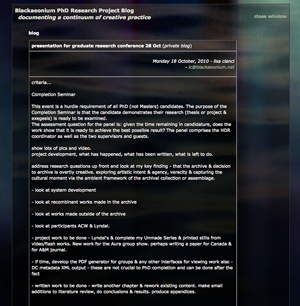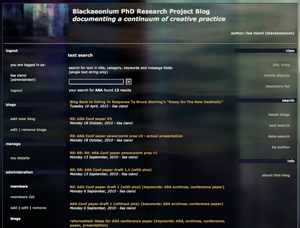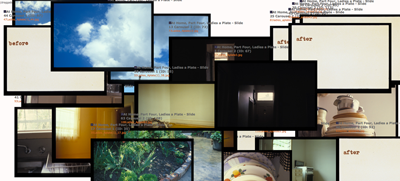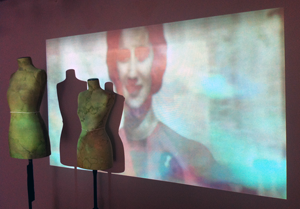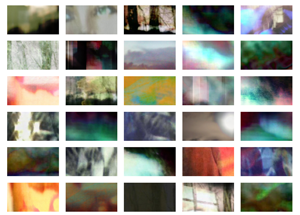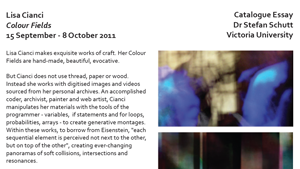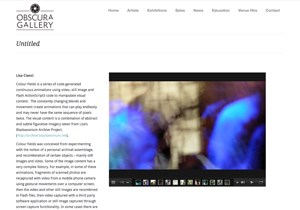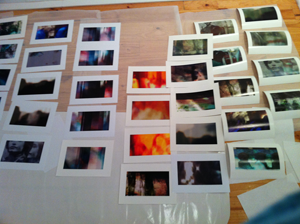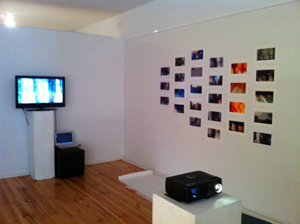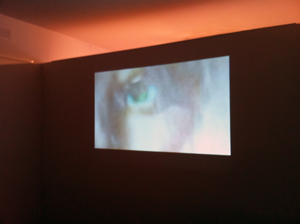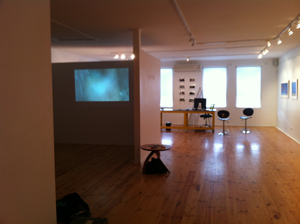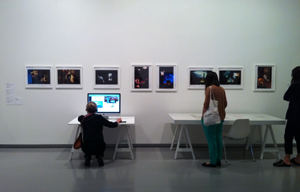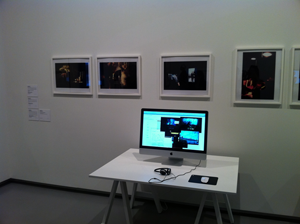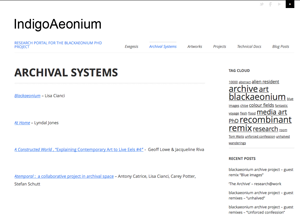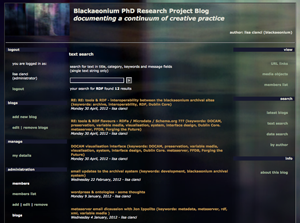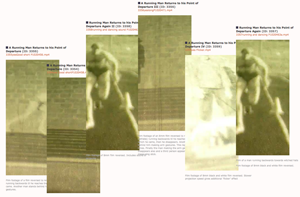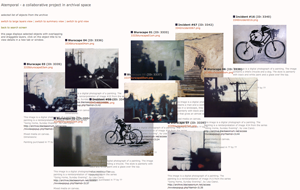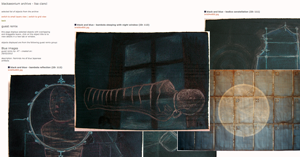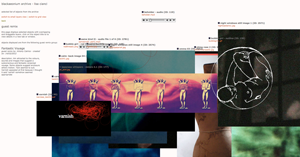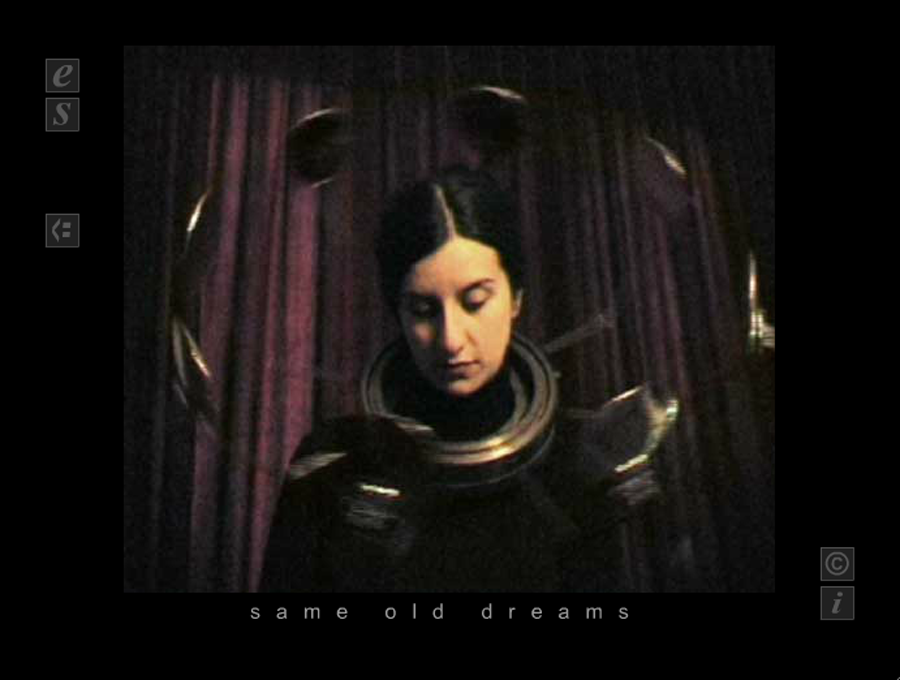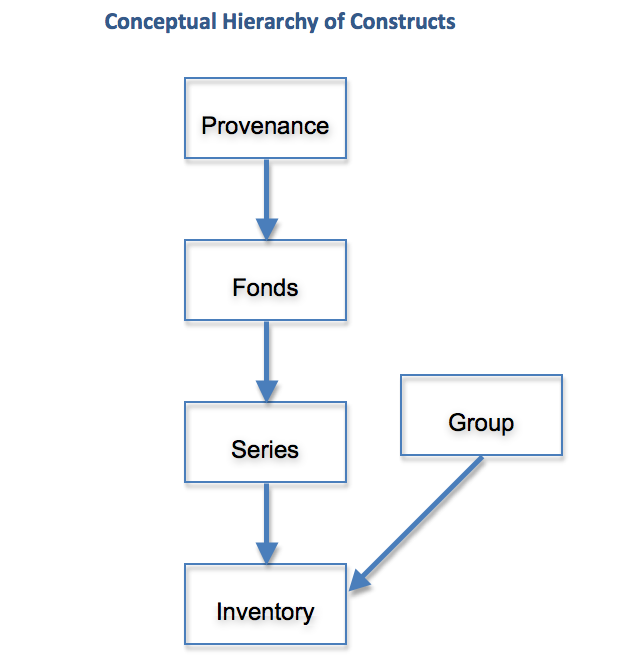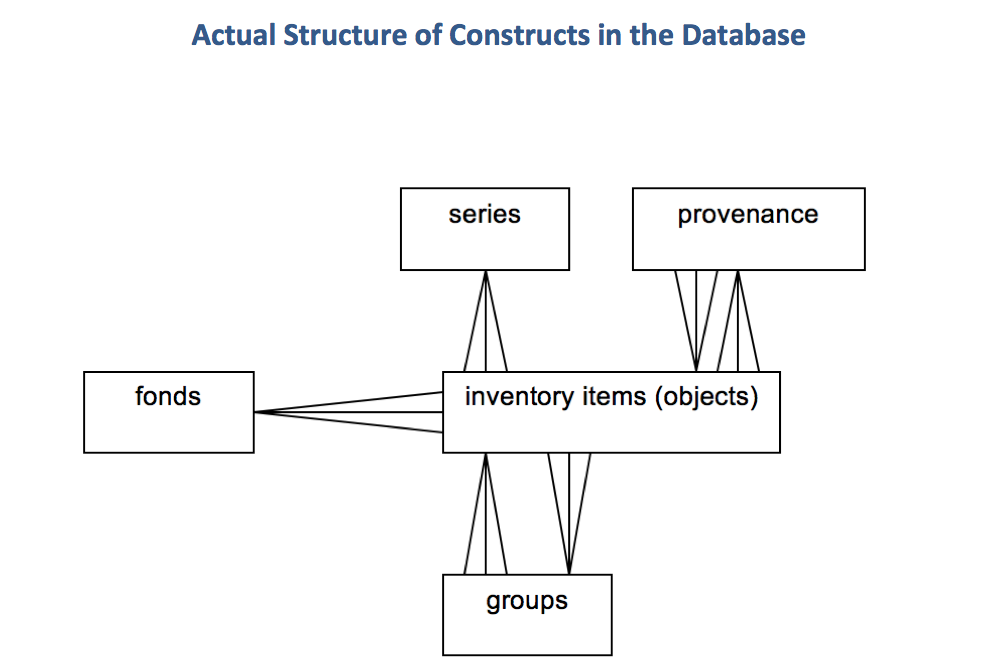homepage & table of contents >> chapter 2
Building the system: methods of development
Developing a "working archive"
The archive, in a certain sense, is meant to be considered a work of art, or perhaps more accurately, as a vehicle for artistic research, as a working model for research as art, art as research. (Watson 1992)
The archival assemblage embodied through the development of the Blackaeonium archival system, has been developed as a “vehicle for artistic research”. This chapter outlines the methods and processes employed to develop a working archive using a practice-based research methodology, involving selection and use of archival elements in creative practice to both future-proof creative content, and to experiment with how the methods used might test the proposition that this would also affect creative practice and the artworks produced.
Preliminary Studies
Before undertaking this research project, my creative practice already involved methods and processes developed through creating both analogue and digital media artworks. These artworks informed the development of this research project proposal because they were my earliest uses of recombinant processes, database-driven artworks, and employed a continuum of creative practice that may have begun unintentionally, but became more of a focus of the practice over time.
Figure 2.001 Same Old Dreams, Lisa Cianci 2001
(click to view larger image)
Figures 2.002 – 2.008 Sketches for Same Old Dreams project
(click to view larger images)Same Old Dreams (Cianci 2001), is an example of a past artwork that was to have a major influence on many works that came after it. Same Old Dreams began as a series of drawings in the 1990s, then became a net-art work that allowed user participation in the artwork, to add text to parts of the “Memorypool” database which then became mixed with my own content for the “dreams”, displayed with Flash animation on the Internet (Figures 2.001 - 2.008). This work operated in much the same way as Mouchette.org where over the years, an archive of user contributions has changed and reformed the website within certain technical constraints.
Figures 2.009 – 2.010 Images of the Narcisse Collar – installed on a plinth and in its purpose-built storage case
(click to view larger images)
Same Old Dreams is primarily a digital work, but it also involved the creation of a sculpture (The Narcisse Collar - Figures 2.009 & 2.010), that was worn by me, captured in an animated image sequence, then used to form the main interface in a digital, database-driven artwork.[1]
Figure 2.011 Rhizomatic view of content relating to "Same Old Dreams" and "Narcisse Collar" projects
Figure 2.012 Layered view of content relating to "Same Old Dreams" and "Narcisse Collar" projects
(click to view larger images)
Same Old Dreams was also one of the earliest representations of the Same Kind recombinant poem that has become a recurrent theme in many of the later artworks (as will be discussed in Chapter 3). Furthermore, Same Old Dreams involved the remix of content from previous works (Figures 2.011 & 2.012), and it has been used to create a range of new artworks after its creation and exhibition in online and physical gallery contexts – some of which are now in the Blackaeonium archival system such as Bubble Girl (2002) and Japanese Whispers (2002). The elements of Same Old Dreams have also partially formed many of the recombinant works within the archive, such as Narcisse Revisited (2007), and Bamboo Girl and her Damaged Sisters #2 (2010) (Figures 2.013 - 2.021).
Figures 2.013 – 2.021 Screen captures from Same Old Dreams
(click to view larger images)
This method of reusing and remixing elements and storing documented versions of the content, became the impetus for the Blackaeonium project. The dimensions of the Records Continuum Model developed by Frank Upward, could have possibilities for artists wanting to create works that could be developed over a long period of time, and show the relationships and traces through the whole collection, or assemblage of an artist’s work.
Methods for creating a system
1. Creation of designs and models for the Conceptual Framework
An archive is a repository for the future, a starting point, not an end point.(Harding 2002)
My interpretation of the continuum model (see Chapter 1 for details of the continuum model) developed through creative practice, demonstrates how the digital online archive allows for an overlapping of pasts, presents and futures - of “durations” and “stages of currency”. The dimensions of the continuum are not only continuous - they are also simultaneous. it seemed that an archival continuum model for the artist could mesh with a model for artistic practice because of the way artists continue to work with concepts and content within a continuum.
As a result, the model I developed through the research for this project overlaps and intersects with the continuum model. Three layers are proposed in my model (Figure 2.022):
- Process : activity, creation, decision.
- Content : content/metacontent, trace of activity, trace of decision, mappings of process, form of content.
- Ambient Framework : database/network, method of expression for content, mechanism for capture of content, means of interaction with content.
Figure 2.022 The Blackaeonium model and records continuum dimensions
The Blackaeonium model of working in a continuum mode is based on concepts from records continuum theory, but has been heavily influenced by the use of web technologies and current new media arts practices.
The initial Needs Analysis and Data Model I produced for the research project (see Appendix 1) was based on elements I considered would be viable and useful to have in a personal archival system for an artist using my own practice as a model. I began the research with the idea that the archive might possibly be a workspace as well as a keeping-place – documenting creative content for the usual archival reasons wasn't enough, there had to be some immediate benefit to the artist in doing the archival work. My previous experiences working with archival systems and content management systems have shown me that users (myself included) won’t take the time to document content properly unless they have a reason for doing it. Immediate retrieval, access and use/reuse at any time or place have proven in my experience, to be the best inducements to getting quality content and documentation in a system[2].
2. Selection of elements from systems and standards
In the spirit of “remixology”, I chose to remix elements from those systems, standards and schemata I had investigated in my research. I selected certain elements from archival systems and standards for documentation; elements from metadata standards that were simple to implement and conducive to interoperability; elements from blog systems that provided easy access to content and were user friendly; and elements from ubiquitous website design features such as tag clouds and shopping carts. These were combined to form the Blackaeonium archival system (Figures 2.023 & 2.024).
Figure 2.023 Screen capture from the homepage of the Blackaeonium archival system and
Figure 2.024 Screen capture from the view/search page from the Blackaeonium archival system
(click to view larger images)
Before deciding to construct my own system, I investigated whether there were other systems that I could use, repurpose, or redevelop that would save me the time and effort of creating a system. I did not find a system that was suitable or easily customisable, so I decided to create my own.
Development of functionality based on testing other archival and social software systems
The research began in 2004. At that time, there were a few free or open source archival systems available such as Archivists’ Toolkit (2006), but none of them suited my purpose, which was not simply to conduct archival documentation, but to also experiment creatively with the content once in the archive. I also investigated whether there were any content management systems or blog systems that could somehow suit my purposes with minor customisation[3].
The blog systems I examined were the two most popular at the time - Blogger and Wordpress. To test these systems I created my own blogs using the free software, and examined the functionality of the systems and the possibility for customisation.[4]
Despite the many features of Wordpress, and the ability to customise the open source code, however, I decided early in the research that because it doesn't allow for the complex contextual documentation required for an archival system, it would take as long to repurpose the Wordpress code as it would to create a simple system myself.
Figures 2.025 – 2.030 Screen captures - evidence of Web 2.0 sites investigated as part of the research project
(Facebook, PAM, Twitter, Wordpress, YouTube, Virtual Art Space)
(click to view larger images)
A number of other Web 2.0 social software systems that are currently in popular usage have been investigated as a part of this research. These include sites such as MySpace (2007), Facebook (2007), YouTube (2007), Twitter (2011), Vimeo (2010), Perpetual Art Machine (2006), Virtual Art Space (2011) and Second Life (2007). The research investigated the technology driving these systems, specific functionality and application, and the creative practitioners that use these systems. Accounts were created in all of these systems listed above to examine how they could be used to store and disseminate content, and might be used or customised as archival preservation systems. Some of my accounts in these systems still exist (as shown in Figures 2.025 - 2.030), and some have been removed.
Despite each of these systems not being adequate as archival systems, they each have something to contribute to the fourth dimension of the continuum – pluralisation; which may occur through the method of “tiering” (as previously described in the Introduction), for content held in the archive. These systems may be a means of “value-adding” and raising the profile of the creative content contained in the archival system, and they may engage different communities to interact with the archival assemblage. As such, I have continued my usage of YouTube, Facebook, Twitter, Perpetual Art Machine and Virtual Art Space as methods of “tiering” and proliferation of content held in the Blackaeonium archival system.
Testing new systems against my own developing archive
Several free archival systems were briefly investigated such as: ICA-AToM (2010); Archon (2011); and CollectiveAccess (2012). Investigation involved comparing the features, interfaces, and testing out demo versions of the software where available. These systems were quickly discounted from this research because the processes were in some cases too complex for a non-professional, the interfaces unable to be customised for the purposes of this research project, and functionality was limited to that for which they were created - archival documentation tools for information professionals.
Later as more user-friendly, open source archival systems for small collections began to emerge, I tested these against my own developing system. They included the following:
1. The Omeka (2010) archival system (Figure 2.031). This is a Dublin Core Metadata compliant open-source archival system that is part archival system, part museum system and part blog (there are some similarities to Wordpress implementation). It has some very useful functionality including the ability to create groupings of items called “Exhibitions”. From my own experiments with the “cloud” version, it appears to be fairly easy to implement and could be used by a non-professional to document a variety of items. Despite these benefits, Omeka does not meet all the requirements for this research at this time because it is lacking the elements that allow for play and experimentation[5].
Figure 2.031 Screen Capture of the Omeka system website
(click to view larger image)
2. A new system is currently in development called Mukurtu CMS (2012) (based upon Drupal (2012)) (Figure 2.032). It has a range of potentially useful functionality for creative practitioners such as: levels of access management; community focus; ability to group items in the archive; and an easily customisable interface. As I have not yet been able to test this system, I cannot determine how suitable it will be for artists to use.
Figure 2.032 Screen Capture of the Mukurtu website
(click to view larger image)
Testing preservation strategies against current research
In trying to determine a specification for the archival system I was to build, I examined systems and standards that were being used by preservation professionals. Not just the archival science literature and documentation, but the work being undertaken by organisations like Rhizome.org and the Variable Media Network Initiative such as the Variable Media Questionnaire and other tools created by the Forging the Future group discussed in Chapter 1.
I found that the archival systems such as those used by national and state archiving institutions and universities, the standards and attendant literature developed for these institutions (although they were extremely interesting to me as an archivist), were too complex and cumbersome to implement for this research project[6]. Furthermore, institutional archives dealing with these kinds of standards and systems are government agency focused - they are not suitable for artists to engage with even if they are able to document artist entities and creative content. Information professionals are required to effectively use these systems: most artists are not information professionals, nor do we have ongoing access to these professionals to do this work ourselves.
Long-term preservation was an unknown issue that I intended to deal with by employing the method of documentation of artworks and creative content, by using, reusing and remixing the content to keep it current and accessible over time, and “tiering” works by linking them to other systems. The use of recombinant creative practice has been both a methodology and a strategy for long-term preservation, because the future development of digital technology is unknown.
3. Selection of information hierarchy (archival and creative constructs) to create the database structure
As Alain Depocas suggests:
it is not enough simply to preserve … (new media)… artworks and hope that the equipment for accessing them will still be available in the future. As with 19th-century panoramas, objects and artifacts won't suffice. We also need to record the context. In other words, the best preservation efforts are insufficient without the support of structured documentation. (Depocas 2001, p.1)
Depocas is addressing the need for archivists to construct a story or narrative of the item within a context to facilitate preservation and access in the long-term, pointing to the significance of a contextual time and place and relationships to other objects, in order to derive meaning from the item, and to know how to interact with it. This is reinforced by Verne Harris:
In all that recordkeepers do they are working with ‘context’, continually locating it, constructing it, figuring and refiguring it. And they do this work primarily through the medium of narrative. (Harris 2001, p. 16)
Implementing constructs is a method that builds a contextual picture of the material that we are documenting.
Figure 2.033 Diagram showing conceptual hierarchy of constructs in the Blackaeonium archival system
Figure 2.034 Actual structure of the constructs in the Blackaeonium archival system database with one-to-many, and many-to-many relationships
(click to view larger images)
The basic archival constructs used in this research project (Figures 2.033 & 2.034) include:
- Fonds (also known as Collection): an accumulated group of items that have some cohesive relationship or characteristic such as having been created by an individual or organisation – following the archival principal of Provenance. The archival principal of respect des fonds (SAA 2004) relates to the concept of respecting the integrity of a whole collection or body of archives whether it is the collection of an individual or organisation.
- Provenance: the chain of authorship, custody, use and ownership of items (Provenance “entities” may be individual creators, or ambient groups or organisations that the individuals belong to). An example of this in the Blackaeonium archival system is A Constructed World – an ambient provenance entity, with related provenance “members” or “agents” Geoff Lowe and Jacqueline Riva as individual artist entities that create the artworks under that collaborative ambient entity name.
- Series: logical groupings of items within the collection, often grouped according to activity, content, function, format or type[7]. The use of a series construct suited this research project because the term is used widely in a similar way in the art discipline.
- Inventory: a descriptive listing of items in the collection – this includes content and format descriptions, information relating to the presentation of the item, and information relating to technical requirements, rights management and access restrictions [8].
To these archival constructs in the Blackaeonium archival system, I added a creative construct.
- The Group: this construct which forms a central element of the Blackaeonium archival system is a creative construct unlike the other levels or entities in the system (above), which are archival constructs. The Group construct allows for any selection of items in the Blackaeonium archival system to be linked as a subset of the archival assemblage with a title and description of the subset. Items may be grouped irrespective of which Fonds, Provenance or Series entity they may belong to. The archival constructs are fixed: they are assigned to the item when it becomes part of the archival assemblage, and do not change over time, whereas Groups can be created at any point in time from the point of “ingest” into the archival system. The Group has become the main entity for developing creative recombinant works from content in the Blackaeonium archival system.
I examined various references from archival science that related to the Australian (Series) System (Hurley 1994) in trying to decide how to interlink the Inventory, Series and Provenance entities. The database structure had to be relatively simple, and I didn't know at the time what I would need to document complex variable media works. Because I was focusing on the item Inventory as the centre of the system structure, I decided that all of the other entities should link to that – although there could be relationships documented between Provenance creators, between Series and between Groups[9]. This may have created limitations within the system for allowing certain ways of documenting entity relationships, but so far, the structure has been capable of documenting all entities and relationships that have been required in the four prototype versions of the Blackaeonium archival system (Figure 2.035).
Relationships (tblrelationships)
relationshipID
relationship
relatedID
granularity
(where the relationship
may be used)1
previous
2
FPS
2
subsequent
1
FPS
3
concurrent
3
FPS
4
parent
5
FPSI
5
child
4
FPSI
6
part of
7
FPSGI
7
has part
6
FPSGI
8
controlling
9
FPS
9
controlled by
8
FPS
10
copy of
11
I
11
original of
10
I
12
related
12
FPSGI
13
metacontent for
14
I
14
has metacontent
13
I
15
has version
16
GI
16
is version of
15
GI
17
has format
18
I
18
is format of
17
I
19
has reference
20
GI
20
is referenced by
19
GI
21
is based on
22
GI
22
is basis for
21
GI
23
requires (dependency)
24
GI
24
is requirement for (dependency)
23
GI
legend
F=fonds
P=provenance
S=series
G=group
I=inventory
Figure 2.035 Table from Appendix 3 – Blackaeonium Archival System Field Definitions, Relationships and where they may be implemented in the Blackaeonium archival system
The Fonds, Provenance, Series and Group entities are simple in their database structure because I didn't initially know how much information would be a minimal requirement in the system. Using a text-area field that could be multi-purpose, would allow the development of contextual information to happen as the research project progressed. I didn't want users (myself included) to become weighed down by extensive contextual documentation. By entering minimal contextual information, focus on the Inventory data entry could become easier, and data entry could be performed quickly by reusing previous Inventory items’ data to populate fields for further data entry. Each item in the archive can potentially be a template for a new item – one just changes the fields that are different, such as Title, Content Description, Dimensions, etc. as can be seen in Figure 2.036.
Figure 2.036 Screen capture from the Blackaeonium archival system showing an interface for creating a new Inventory item from an existing one
(click to view larger image)
4. Development of Specific Metadata
A selection of metadata schemata and standards, scripting languages and frameworks investigated for this research included:
- ISAD(G): General International Standard Archival Description (2007), International Council on Archives;
- DCMI Metadata Terms (2007), Dublin Core Metadata Initiative;
- SMIL (Synchronized Multimedia Integration Language) (2007), World Wide Web Consortium;
- METS (Metadata Encoding and Transmission Standard) (The Library of Congress 2005);
- MPEG-21 DIDL (Digital Item Declaration Language ) (2007), Moving Pictures Experts Group;
- RDF/RDFa, Microdata and Microformats (and associated scripting languages)(W3C 2012a); and
- Schema.org (2011).
Initially, I was unsure of the requirements for Inventory level and contextual description to best suit a creative practice. Simplicity was necessary for the system functionality, as was the potential for output to other structures or systems, and interoperability with other systems at a later stage. The metadata standards listed above were briefly investigated by researching online, and checking elements in particular standards against requirements I had for the Blackaeonium archival system (see Appendix 2: Blackaeonium Archival System Specification Document (and additional technical information)).
In structuring the archival system to allow for multi-level documentation based upon the ISAD(G) guidelines for archival description, I also selected metadata elements from the Dublin Core Metadata Initiative for the Inventory level description precisely because it is a minimal standard suitable for digital resources. I structured the system around the Inventory item (as shown in Figure 2.037), because this would be the point for experimentation and play in the archive. It was also a requirement to be able to build complex relationships between items, and between entities – Provenance, Series and Groups: relationships that could be built at all levels of the system[10].
Figure 2.037 Screen capture showing an example of inventory description from the Blackaeonium archival system
(click to view larger image)
5. Formulation of a Strategy for Digital Multimedia Formats
The scripting languages investigated such as SMIL and the MPEG21 format were analysed to determine if they might be suitable for use with the Blackaeonium archival system. The decision was made to allow the use of unlimited digital file formats and use multimedia “metacontent” in a variety of digital file types to ensure that variable content was documented in more than one format, a strategy for future-proofing the content in the archive where future file formats are unknown. Formats currently recommended as the most stable such as PDF, TIFF image, MPEG video, WAV audio etc, cannot be relied upon as the only way of carrying content into the future. As artist Alan Sondheim discussed in our email correspondence, he only trusts ASCII text as a long-term format – a logical concept, given its basic format and encoding:
I'd probably consider the textual material primary - but part of the reason is that ascii is ascii; it reproduces within a limited set of symbols, reasonably well. Information theory and potential wells are important here - and ascii pretty much survives noise and occupies an incredibly small bandwidth.
(personal email correspondence with Alan Sondheim 17/05/2010)From my own experience of working with digital multimedia for over 16 years, and from the research conducted for this project, I believe that the best strategy to enable artists to be free to use unlimited digital file formats (and future-proof our work), is the method of reinterpreting artworks using different digital file formats to document and recreate content.
6. Creation of a Database Structure
Figure 2.038 Database relationships diagram from Appendix 4: Blackaeonium Archival System Database Structure
(click to view larger image)
The database design was developed from a spreadsheet (part of the functional specification) that listed the fields that would be required in the system (Figure 2.038), and which element from Dublin Core or ISADG(G) the fields complied with (see Appendix 3: Blackaeonium Archival System Field Definitions). Later in the research, when the Variable Media Questionnaire (VMQ) was developed, an additional column was added to this spreadsheet to examine where the kinds of documentation for source, materials, environment and installation information could possibly exist in the Blackaeonium archival system[11].
The similarities between the VMQ and the Blackaeonium archival system lie in the documentation of an artist’s intent for their artwork – not just documenting the nature and environment of the artwork for the present, but to allow the artist to consider how their work may possibly be presented in the future, especially where specific technologies are used that may become obsolete. Can a work be reinterpreted and exhibited in a different way? Or is the scope for this limited? The artist decides what is acceptable, or if the work can possibly be shown again outside its original time and place. In some cases, work may not be re-presentable.
One difference between the VMQ and the Blackaeonium archival system is that the VMQ is initiated by an institution: museum; gallery; archive, and usually has a curator or other professional involved in the process (as well as the artist where possible).
Other differences include:
- The central focus of the VMQ on the “artwork”. The VMQ involves documentation about completed artworks that have already been exhibited.
- The VMQ tends to be used for works that are already determined to be significant in some way, or works by an artist who is considered significant.
- Although an individual artist could use the VMQ without institutional intervention, it doesn't contain the functionality for recombination or remix of content.
- Its usage is for documentation of artworks once they are complete.
The Blackaeonium archival system doesn't determine a single type of entity for where the “artwork” lies in the system. Here, an Inventory item, a Series, a Group, or the whole Fonds (as an assemblage) could be classed as an artwork. The idea of a “finished” work thus becomes a plastic notion. This concept is supported by Jon Ippolito who states:
those artists, and those institutions, who accept the concept that an artwork can change may find a number of their time-honored assumptions changing along with it. They may cease to view the conservator’s job of preservation as independent from the curator’s job of presentation. They may begin to picture a lasting artwork not as a stony relic—for stone is brittle—but as a succession of linked events that, like a stream of water, endures by remaining variable. (Ippolito 2003)
By implementing archival methods for documenting “records” or “objects” for the artist, rather than there being a curatorial focus on the completed artwork, there is freedom for the artist in focusing on creative processes and content, and not just completed works. Some items in the archival system may be finished artworks, but other items will be support material, component parts, metacontent or versions of other items in the archive. Content in the archival assemblage may not be considered significant, or linked to a significant artwork. These methods allow for greater experimentation with what material the artist’s archive can hold. An item in the archive that may not be a finished work: some small element like a sketch or piece of text, may at some later date become a significant part of an artwork, or may be transformed into something quite different (see Figures 2.039 - 2.041 for examples of this).
Figures 2.039 – 2.041 Examples of the Same Kind recombinant poem – originally documented in hard-copy visual journals, used in Same Old Dreams, then reused in other works and recombinant remixes in the archive such as Like a Heavy Object in Deep Water, then taken out of the archive and used in the Unmade series
(click to view larger images)
7. Experimentation with outputs for Interoperability
The structured data developed for this research project is designed to:
- enable complete or partial output to a variety of metadata standards if required;
- enable other possible output formats such as output to ASCII text, XML, RSS feeds, RDF formats such as RDFa and Microdata, or migration to another database application.
XML and RSS feeds were developed in the second prototype (Figures 2.042 & 2.043) and experiments with RDFa and Microdata are currently underway with the fourth prototype.
Figure 2.042 XML output from the Blackaeonium archival system
Figure 2.043 RSS feed from the Blackaeonium archival system XML output
(click to view larger images)
I contacted Jon Ippolito (developer of the VMQ) to discuss the tools used in his variable media preservation projects: in particular the nature of metadata and interoperability in these projects because I was struggling with the dilemma facing many developers – how best to output the metadata from the system for semantic searching and interoperability, and how important is this interoperability between the “islands of culture” (Ludovico 2010) we are creating online?
It seems that over the years of developing this research project, there is not yet one standard that everyone uses, nor one set of terminology. [12] After discussions with Ippolito and others in the field, it is apparent that rather than debating which standard to use, we need to deal with the real world situation of interoperability for a variety of creative content systems. Even if our “islands of culture” are using different systems and standards, we can interlink our sites by outputting descriptors in our websites incorporating formats such as RDF, RDFa, Microdata and Schema.org that allow our systems to connect via semantic search enabled servers.
Initially I developed various XML output generators (Figure 2.044), and an RSS feed as a part of the Blackaeonium archival system prototype as a means of testing the interoperability of the system with other frameworks[13]. Current versions of the prototype have the RSS feed disabled because it was not widely used, and other means such as Twitter and blog posts have become a better way of “syndicating” the new content in the archival assemblage. The XML output is still functional, but hidden from public view as it has not yet been required to transfer data to another system.
Figure 2.044 Screen capture showing the Blackaeonium archival system with XML output - Prototype 2
(click to view larger image)
Other outputs such as developing FOAF (Friend of a Friend Project 2012) for Provenance entities, and developing RDFa or Microdata output within the HTML page for Fonds, Series, Group and Inventory display pages are currently being developed to enable the Blackaeonium system to form linkages with other “islands of culture” through servers such as the Metaserver (developed by Ippolito and others in the Forging the Future group).
the Metaserver doesn't require importing or exporting data. Instead it creates live links that allow data from outside sources to appear alongside records in a proprietary collection management system […] Rather than force everyone to conform to the same data standard, this approach automatically ties together related records in separate institutions, helping artists and curators with similar concerns discover each other and share solutions to preservation problems.
(Jon Ippolito, from email correspondence with Lisa Cianci 04/01/2012)
At present, the Blackaeonium system is being redeveloped to contain some Microdata and possibly some Schema.org output in the PHP pages for certain parts of the Blackaeonium archival system[14]. There is also the possibility of using the APIs (Application Programming Interfaces) currently being developed by Forging the Future to enable connection to the Metaserver[15].
Figure 2.045 Screen Capture of Indigo Aeonium Wordpress Portal showing Blog Posts that link to guest remixes
and other new work in the Blackaeonium archival system
(click to view larger image)
While these formats are being developed, the use of a Wordpress site titled “Indigo Aeonium” (Cianci 2011) has been implemented as a temporary means of creating an overarching website linking all of the archival systems and other parts of the research project under one portal (Figure 2.045). Despite my rejection of Wordpress as the archival system itself, it is functioning as a temporary interoperable semantic output and search engine optimisation (SEO) generator, while the best methods of employing RDF output for the Blackaeonium archival system are tested. The Atemporal collaborative project archival system is currently testing the most appropriate structures for semantic search, HTML5, CSS3, jQuery and associated code, with new interfaces developed as required. This will become the fourth prototype of the Blackaeonium archival system.
8. Design and construction of Interfaces
Interface design in the Blackaeonium archival system began with a few early sketches, which became the main search page: <http://archive.blackaeonium.net/access/index.php>, with it’s three-column search-view-select design, utilising the shopping-cart section on the right to store selected items that could at some point be saved as a recombinant group.
Figures 2.046 – 2.051 Selected screen captures from the PhD research blog demonstrating documentation
of interface development for the Blackaeonium archival system
(click to view larger images)
The rhizome interfaces were also designed from sketches to enable the complex relationships between objects to be visualized in an HTML/JavaScript, 2-dimensional format. This enables the user to navigate through the archive in different ways, moving from item to item based upon different criteria such as relationships, contextual links, or tagged keywords.
Artists working with digital media, particularly on the networks, are acutely aware of information overflow and that design of navigation through these spaces has become a demand of aesthetic practice.
(Vesna 1999)The Rhizome.org website (Rhizome.org 2006) has been influential in considering different ways of moving through the archival assemblage to create experimental interfaces that still contain a sound underlying structure. The essential documentation of the work is there, but the audience can engage with the content in a more playful and creative way.
Artists were commissioned to devise creative interfaces for the Rhizome.org Artbase. Figure 2.052 shows a more typical webpage layout for accessing artworks - metadata held in a database is searchable by artist name, keyword descriptors, or work title. Whereas Figure 2.053 shows a star-field interface ‘Starry Night’ (Galloway, Tribe & Wattenberg 1999), developed by Alex Galloway, Mark Tribe and Martin Wattenberg for accessing the same artworks by using the mouse to interact with the stars – the layout of the constellations determined by keyword links generated by the underlying database metadata. Figure 2.054 shows the ‘Troika’ interface (Jevbratt 2002) developed by Lisa Jevbratt, where each pixel represents a point of entry into the Artbase. The potential for developing interfaces for access to these works is endless.
Figure 2.052 Rhizome.org Artbase interface
Figure 2.053 Rhizome.org "Starry Night" interface by Galloway, Tribe & Wattenberg (image with permission from Galloway, Tribe & Wattenberg)
Figure 2.054 Rhizome.org "Troika" interface by Lisa Jevbratt (image with permission from Lisa Jevbratt)
(click to view larger images)
These commissioned interfaces were studied while the Blackaeonium archival system was in its initial development, as a non-traditional, more artistic means of engaging with the archive.
Figure 2.055 Example of relationship trajectories in the Blackaeonium archival system (tree structure)
Figure 2.056 Example of relationship trajectories in the Blackaeonium archival system (circle structure)
Figure 2.057 Example of layered interface in the Blackaeonium archival system
(click to view larger images)
This kind of functionality was required for the Blackaeonium archival system (see Figures 2.055 - 2.057)– it is an artwork whilst also being an archival space with the requisite information available and easily accessible when required – but not necessarily prominent in the homepage.
Figure 2.058 Narcisse Revisited 2007, recombinant artwork from the Blackaeonium archival system
(click to view larger image)
The Blackaeonium archival assemblage is the consequence of a practice (Grosz 1994, p.167), with fragments, flows and movements. The archival assemblage and the content within is an extension of the artist’s body and also exists a body of work. The archival assemblage is subject to endless experimentation and recombination via the ambient framework of database/network and via the creator/audience in relation to the content object and the collection. Interfaces such as the layered Group display shown in Figure 2.058 embody this idea.
The interface design for the overlapping layers (as shown above) developed out of a need for some way to experiment with the content in the archive. By creating the draggable layers that randomly position themselves each time the page is loaded, content can be recombined, pushed about, overlapped. This interface has also become an artwork in itself – the recombinant groups displayed in this interface form a “Regenerative Remix” (Navas 2011c) that maintains the “spectacular aura” of the original item, but allows for play and experimentation – not just by the creator, but by the audience, as a means of engagement with the content in the archive[16].
There are many tensions in developing interfaces for the archival system that is also an artwork. The layered, draggable interface used on the homepage is not a “splash” page: it is the kind of homepage an artist would require, although perhaps not one an archivist may require. The homepage is a dynamic part of the whole system: it is the first point of contact with the archive, and as such, the artist can select any "Group" of items to present as that first viewpoint (and change that selection at any time). The draggable layers interface is an aesthetic device that operates as a metaphor for the multivalence and complexity of the archival assemblage that changes and shifts and moves. We can only engage with a small part or facet of the greater assemblage at one time, but the interface is the beginning of a journey through that assemblage.
The system is designed for the artist and the artist’s audience. It is a personal space that invites the audience in to engage immediately with the work, and is inviting for the artist to use as a central location for documentation of artwork and process. Using the overlapping layers interface as the first point of contact with the archival assemblage has been advantageous for the content being presented in online and physical gallery contexts. The archive was used in the Colour Fields exhibition at Obscura Gallery in 2011, and Chapter 4 will discuss the installation of the At Home series digital archive by Lyndal Jones in the gallery space at Monash University Museum of Art. The homepage interface was redeveloped for the At Home archive to show the overlapping layers, the tag cloud, and selected links to recombinant groups – to maximize creative ways of accessing the media content immediately – rather like accessing physical works in a gallery where the visual content is the primary focus, then information about the artwork may be accessed if one chooses to do so.
Figure 2.059 Screen capture of MONA website showing The MONA “O” hand-held, touch-screen device
(click to view larger image)
The Museum Of New Art (MONA 2012) in Tasmania is a physical example that demonstrates this point (Figure 2.059). There is no physical labelling of the artworks within the gallery space at MONA. Every element of the space has been designed to enhance the audience experience and signage does not interrupt the visual flow. By accessing the personal “O” hand-held touch-screen device (provided on entry to the gallery), visitors may then find information about an artwork (if they choose to, when in physical proximity with the artwork), and may save selected work to view online later – like a shopping cart. This is similar to the way the Blackaeonium archival system functions (users may click a link at any point to save the item they are viewing to the "shopping-cart" area).
Usability is necessary for the archival system to allow access to the content, but there are aspects of a creative work that may not necessarily comply with usability “best practice”. In presenting the archival assemblage in an online, interactive, creative form, do we need to "show all", and present everything in a traditional representation of an archival finding aid? All the content is accessible at any time with a single click via more typical interfaces which can be accessed from the “About” page (Figure 2.060) and the “View/Search” page, but it is not aesthetically interesting to make the Blackaeonium archival system look like a standard informational website. That was not an intention of the research. This research project was not concerned with standard and traditional presentations of content and information, rather how these elements could be reinterpreted as a part of creative practice.
Figure 2.060 Screen Capture of the “About” page in the Blackaeonium archival system
<http://archive.blackaeonium.net/about.php>
(click to view larger image)
One reason for the homepage not being explicit in presenting the archival metadata is to experiment with the way users approach the content – to push a certain facet of the assemblage to the fore. The archival documentation is all there to be accessed, but we don't need to make it accessible to everyone all the time. It may seem a little obscure to some users initially as it is a site to explore and investigate. Many online artworks such as Mouchette.org and Dollspace might seem obscure to the same users.
Methods for creating the project: the systems, the artworks and the blogs
This section is a summary of the broad development stages of the research project, outlining the work that was done and the methods used (following a practice-based research methodology). Each numbered area below contains: images of elements from the research project; and links to appendices, blog entries and external websites that are evidence of development of technical and creative content from the research project.
1 Development and initialisation of the PhD Research Blog 2004
The PhD research blog was one of the first parts of the project to be developed because I regarded it as the main area for documenting project development. I customised this blog from a system I had developed myself for a research project at Victoria University. The blog was used from April 2004, and continues to be used to note research and creative developments, link to files, upload development content, and document system development, and creative content development (Figures 2.062 & 2.062).
Blog URL: <http://www.blackaeonium.net/phdblog/> (requires a login to view the blog posts - username and password = guest)
Figure 2.061 Example of an earlier version of the PhD research blog c. 2006
Figure 2.062 Example of the current version of the PhD research Blog 2012
(click to view larger images)
2. Creation of the first Blackaeonium archival system prototype 2004-2005
This first prototype was developed using ColdFusion and an MS Access database as a “kludge” (proof of concept based upon patched together code elements), based upon the system Needs Analysis (see Appendix 1: Blackaeonium Archival System Needs Analysis). This system is no longer operational (its parts are archived in the research blog) (Figures 2.063 - 2.065). At the time of development, it allowed me to test a variety of concepts, and to identify the requirements for the next prototype version.
The Database structure was developed at this time with the first field definitions comparing the Blackaeonium structure with Upward's Continuum Model, the Dublin Core metadata standard and the ISAD(G) standard for archival description.
Figure 2.063 – 2.065 Early images of the first Blackaeonium archival system prototype development and interfaces
(click to view larger images)
3. Documentation of the technical development 2004-2007
The Specification Document has been a form of parallel development document showing technical developments and justifications for decisions. Also included are the database structure and field definitions documents.
- Appendix 2: Blackaeonium Archival System Specification Document (and additional technical information)
- Appendix 3: Blackaeonium Archival System Field Definitions
- Appendix 4: Blackaeonium Archival System Database Structure
4. Creation of the second Blackaeonium archival system prototype 2006
This prototype was developed in PHP/MySQL, which required self-education and experimentation in different scripting languages. The work done at this time included:
- building coded elements to serve content from the database and enable interactivity;
- testing of all functionality;
- development of PHP web pages as required to quickly generate interfaces that could be used immediately;
- archival documentation of my own artworks in the archival system, which began at this time as part of the creative practice, and also as part of the testing and evaluation process.(see Figures 2.070 – 2.072)
The PhD blog was used to document and track development, and the specification document was updated to reflect changes and new content (see Figures 2.066 - 2.069).
Links to relevant content:
- Series of creative work developed at that time such as Same Kind II and Same Kind III.
Link to Same Kind III videos as a recombinant group in the Blackaeonium archival system: <http://archive.blackaeonium.net/access/integratedgroupsm.php?groupid=5>;
- the PhD blog <http://www.blackaeonium.net/phdblog>;
- Appendix 2: Blackaeonium Archival System Specification Document (and additional technical information)
- Appendix 3: Blackaeonium Archival System Field Definitions
- Appendix 4: Blackaeonium Archival System Database Structure
Figure 2.066 – 2.072 Screen captures showing selected examples of development documented in the PhD research blog from 2006, and interface screen captures of the Blackaeonium archival system from 2006/2007
5. Documentation and creation of artworks using the Blackaeonium archival system 2006 – 2009
My own artworks and creative content continued to be documented throughout this time. I also began to create recombinant works from my own archive around 2006/2007 (such as Bubble Girl and Like a Heavy Object in Deep Water), and concepts were forming for new works derived from content in the archive (such as 10,000 Days & Nights and Same Kind III).
(see Figures 2.073 & 2.074)
The ACW project began at this time, and the work from “Explaining Contemporary Art to Live Eels #4” was documented in the ACW iteration of the Blackaeonium archival system <http://acw.blackaeonium.net>.
(see Figures 2.075 & 2.076)
Figures 2.073 – 2.076 Screen captures from the Blackaeonium archive and the ACW archive
(click to view larger images)
6. Online presentation/exhibition of artworks 2007-2012
During this time, I was engaged in a continuous process of creation, reflection and evaluation of the artworks I was creating. The Blog was used as the main method for documenting this development, and the artworks are also evidence of the creative development and methods employed.
Work developed through the research project began to be evaluated through presentation and exhibition in online contexts via the method of “tiering” to proliferate content across the Internet. Examples of international online exhibition and presentation I was invited to participate in include:
- DVblog (2007) (see Figure 2.077);
- I-Ocean (JavaMuseum 2004) (see Figure 2.078);
- Perpetual Art Machine (PAM) (see Figure 2.079);
- JavaMuseum (2010) (see Figure 2.080);
- Rhizome.org Artbase (see Figure 2.081).
I also created my own online exhibitions through:
- My website <http://www.blackaeonium.net>; and
- The Virtual Art Space (VAS) 3D gallery <http://www.3dvas.com/galleries/profile/artists/artistProfile.php?username=blackaeonium>
(see Figure 2.082).
Figures 2.077 – 2.082 Screen captures of my artwork from online exhibitions and presentations
(DVblog, I_Ocean, VAS, PAM, JavaMuseum and Rhizome Artbase)
(click to view larger images)
7. Presentation of the research at Conferences 2005 – 2012
Feedback from peers and colleagues was useful in the evaluation of the project progress, and how this work fitted in with other creative practitioners’ work. I made several presentations of the research work at RMIT University and Victoria University, and presented at an archival conference in 2010:
- Vital Signs, RMIT University 2005 (see Figure 2.083);
- Narrative Research Conference, Victoria University 2006 (see Figure 2.084);
- Graduate Research Conferences, RMIT 2009 and 2010 (see Figure 2.085); and
- Presentation of a paper at the Australian Archivists conference, Future-Proofing 2010 (see Figure 2.086).
Figures 2.083 – 2.086 Screen captures of a selection of PhD research blog entries showing documentation of content for presentations and papers
(click to view larger images)
8. Creation of the third Blackaeonium archival system prototype, 2009-2011
Development of the At Home series archive was concurrent with developments and updates for the third Blackaeonium archival system prototype. During this time, the code was improved, and new interfaces were developed. This work is documented through:
- the PhD blog <http://www.blackaeonium.net/phdblog>;
- the At Home series archive <http://athome.blackaeonium.net>, current example of Prototype 3 (see Figure 2.087) (a guest login must be given to access all of the contents in this archival system);
- my own work that continued to develop at the same time. The Unmade series began via the recombinant artwork Made/Unmade (see Figure 2.088);
- the Blackaeonium archive <http://archive.blackaeonium.net>, current example of Prototype 3;
- Appendix 2: Blackaeonium Archival System Specification Document (and additional technical information).
Figures 2.087 – 2.088 Screen captures of the At Home archive showing a layered interface and recombinant grouping,
and the Blackaeonium archive showing the recombinant work Made/Unmade
(click to view larger images)
9. Exhibition of artworks, 2010 – 2012
Development of artworks continued through this time, and exhibitions in physical spaces occurred for work developed from the research project. By undertaking major series such as Colour Fields, I could create, reflect, evaluate, and create again, each new work within that series demonstrating a continuum of development. There were also new recombinant works developed throughout this time.
Physical exhibitions include:
- Aura: the Haunted Image at Level 17 Artspace (see Figure 2.089);
- Colour Fields at Obscura Gallery (see Figures 2.090 - 2.097).
- The archival system for Lyndal Jones’ At Home series was also shown at MUMA in the exhibition titled "A Different Temporality: Aspects of Australian Feminist Art Practice 1975-1985” (McFarlane 2011) (see Figures 2.098 - 2100).
Figures 2.089 – 2.100 Documentation of exhibitions: Aura: the Haunted Image; Colour Fields, A Different Temporality.
(click to view larger images)
10. Development of a Wordpress Portal and creation of the fourth Blackaeonium archival system prototype 2011-2012
While the development has begun for the fourth Blackaeonium system, a Wordpress “portal” has been created to enable access to all archival systems, creative projects and the online exegesis for this research project. Using Wordpress is also enabling the testing, evaluation and development of Search Engine Optimisation (SEO) modules for the Blackaeonium archival system, and modules for interoperability based upon RDF, RDFa, Microdata, Microformats and Schema.org content output. The Blog is being used for documentation of conceptual and technical developments.
- Indigo Aeonium Wordpress portal <http://indigo.blackaeonium.net> (see Figure 2.101);
- PhD research Blog <http://www.blackaeonium.net/phdblog> (see Figure 2.102); and
- Atemporal Project Archive <http://atemporal.blackaeonium.net>, the fourth prototype under development[17] (see Figure 2.103).
Figures 2.101 – 2.103 Screen Captures from Indigo Aeonium Wordpress portal, and the PhD research blog
(click to view larger images)
11. Evaluation of the system through creative projects with participants 2011-2012
As this project is a creative endeavour, the best way to test the system is through creative acts by artists and audience members. Further testing and evaluation of the archival system is occurring through:
- The Atemporal project – a collaboration in archival space where artist participants use the archive and create new content from the archive, as I have done throughout the research project <http://atemporal.blackaeonium.net>. (see Figures 2.104 & 2.106)
- The “Guest Remixes” project is allowing selected audience members to enter the archive to engage and participate in a creative way that is then saved as a part of the archive <http://archive.blackaeonium.net> (select "guest remixes" from menu). (see Figures 2.107 - 2.109)
The Atemporal artist participants are providing useful feedback for improving the archival system, but are also developing their own creative practice based upon the archival continuum model. Preservation strategies are employed in this project through creation of recombinant work, collaboration, remix and curation of content in the archive. Content from this project will be exhibited in virtual and physical spaces with several publications planned. This work is also “tiered” through social media sites (such as Facebook and Twitter) and posted in the blog section of the Indigo Aeonium Wordpress portal <http://indigo.blackaeonium.net>, and other online systems (further details in Chapter 4).
- Feedback from the Atemporal artists is informal and meetings and emails are being documented in the PhD Blog <http://www.blackaeonium.net/phdblog>.
- Feedback from Guest Remixers is being collected through an online “Survey Monkey” survey (see Appendix 5: User Testing and Guest Remixes Questionnaires & Surveys).
Feedback has been useful in directing future developments and is already being taken on board in Prototype 4 – for example: development of more integrated instructional elements for using the Blackaeonium archival system and improvement of workflow for archival documentation.
Figures 2.104 – 2.106 Screen captures of content from the Atemporal Archive Project
Figures 2.107 – 2.109 Screen captures of “Guest Remixes” from the Blackaeonium archival system
12. Development of “Future-Proofing for Artists” a series of educational modules - 2012
Based upon the identified requirement for education of artists and creative developers to undertake their own archiving and preservation strategies, modules for educating artists under the title “Future-proofing for artists” have been developed. A pilot of this educational content was trialled with Advanced Diploma students in the Digital Media Program, School of IT and Creative Industries at Victoria University, and two further modules will be taught to Visual Art and Creative Industries Diploma students from the same School in the second half of 2012.
Students are working with methods from simple file naming and directory management, to considering storage media, migration and emulation strategies for their own content, and ultimately considering and documenting their intent for how their artwork should be presented and re-presented over time.
Class content and feedback thus far is summarised in Appendix 6: Future-Proofing for Artists - Educational Modules and Student Feedback and shown in online learning resources listed below:
- Digital Media - Workshop 2 <http://lisacianci.vucreativeindustries.com/2012/WS2>
- Visual Art - Context & Culture 4 <http://lisacianci.vucreativeindustries.com/2012/CX4>
- Creative Industries - Creative Technologies <http://lisacianci.vucreativeindustries.com/2012/CRT>
top of page | homepage & table of contents | next section - chapter 3
Endnotes
[1] The Narcisse Collar was also developed from drawings from the 1990s, where the idea was first conceived. At that time I didn't have the means to construct the collar in my drawings. Serendipity via the lucky find of a truck bearing that would just fit over my head and rest on my shoulders, enabled artist Carey Potter to create the spinning collar, and the work developed from there.
[2] Although I have worked as a professional archivist for a number of years, as an artist I still have a resistance to self-documentation. I see myself as no different to many artists and creative practitioners. The creative process takes many shapes and forms, and may involve any number of ad hoc methods and processes. One tends to move from one project to the next to keep the continuum of creation going. Like so many other artists I know, I am time-poor. This is partly because the experimental and variable media works I create, have little commercial market. Many of us work as educators in universities, or in other various modes of employment to self-fund our creative practices, or apply for funding from cultural organisations to undertake creative projects, which also takes a great amount of time. Undertaking this practice-led research project had to have some immediate benefit for my creative practice, and by extension, that of other artists.
[3] At the time systems like Alien Brain (not free, nor open source software) and other available content management systems, were mostly third party proprietary software that I didn't want to commit to over an extended period of time, that I couldn't afford, and they weren't focused on archival documentation. The main function of these commercial content management systems is to enable access and sharing of content in the present and immediate future by groups or teams of multimedia developers.
While undertaking this research project (2004-2012) there have been many new open source software applications published online for free download as tools to assist with preservation of digital media. Early in the research, some of the tools investigated included systems: that are generally either emulators such as the National Library of the Netherlands’ Dioscuri (2007); that enable access to older media formats; or are metadata extraction tools such as the National Library of Australia’s Xena (2007) and the National Library of New Zealand’s Metadata Extraction Tool (2007). These tools each have their own benefits, and would be useful to a number of collecting archives, or may even be used in conjunction with an archival system.
[4] Blogger is no longer in operation (I keep receiving emails to move my “legacy system” to another format), but Wordpress has since become a ubiquitous open-source, configurable Web 2.0 system with many themes, widgets and plug-ins that can be adapted to suit a number of purposes.
[5] …although many widgets are being developed for Omeka that may at some point provide more creativity in the archive other than the “Exhibition” of selected items as a subset of the collection.
[6] Creating a 5-entity record keeping system (such as that used by the National Archives of Australia), for an individual artist to work with, was not a manageable strategy within the scope of this research project. It was not feasible for me to build such a complex system because this was not the entire rationale for the project. Within the scope of this creative media research project, as a sole developer and artist, I also had to create a substantial body of artworks, and undertake the documentation of these artworks (and work with artist participants), therefore, the system structure had to be simplified.
[7] The “Series” construct as used in this project owes its initial development to what is known as the “Australian ‘Series System”(Hurley 1994), based upon a long history of development beginning with archivist Peter Scott in the 1970s, an Australian archivist that developed a method of arranging and describing government records that has been influential in the archival science profession ever since.
This archival method enables the description of records in a continuum from creation onwards – “records” are grouped into series that are created by provenance entities. These series may be interrelated as the provenance entities are interrelated – for example, government agencies change mutate, split, and are amalgamated over time. Scott’s system allowed for the fluid documentation of this change of provenance whilst also documenting the way records were created and used by these ever-changing agencies.[8] The definitions of these constructs have been summarised from two main sources: Keeping Archives (Ellis 1993); and the SAA glossary of terms (SAA 2004).
[9] The Provenance is linked to the item, not the Series, and allows for more than one Provenance entry per item (a many-to-many relationship). The system was structured in this way to allow for the documentation of both ambient and record keeping Provenance entities, and also to allow for the instance where a Series may contain items of different Provenance – for example, where an artwork has been created by a collaborative group and certain components have been created by certain individuals. The Provenance entities for a Series could be traced back through the items in the Series – Provenance is not linked to the Series table directly or via a Relationship type. The same structure exists for the Group – particularly important for the remix where the remix creator may not be a Provenance entity.
This structure allows for guest users to enter the system and create remixed groups that then enable tracing the original creator for each separate item in the remix. Public “guest” users are not considered Provenance entities as such, and the system differentiates between Creator entity remixers, and “Guest” or “Audience” entity “remixers”.
The Provenance <- Inventory -> Series linkage was also chosen because the scale of the archival system was perceived as not being as great as that of a government agency where you have many agencies that change and morph over time, and many thousands of staff members that work within those agencies creating and maintaining vast quantities of records. It is possible to identify a chain of custody through Provenance relationships, Series relationships, Inventory item relationships and Group relationships. Some interfaces exist within the system to manage these relationships, and further work is planned to allow for different visualisations of these relationships according to artist and project requirements over time.
This idea of centring the archive around the Inventory item and not the Series, seemed logical when developing the system structure because an individual item could be considered an artwork, or part of an artwork, or a record or metacontent for a concept or artwork. There is a fine “granularity” for describing and differentiating Provenance in the Blackaeonium archival system. This may differ from the way many archival systems work; it suited the requirements of this research project primarily for creative purposes.
[10] The functional specification document developed for this research project contains a table of information that initially compared the fields I thought I’d need with the ISAD(G) and Dublin Core Metadata terms – to see where my requirements fitted with these two standards for description of the objects in the Blackaeonium archival system. Over the course of the research project, these field definitions changed slightly to suit the requirements of the artist participants (myself included). The specification document also changed in focus; rather than trying to meet one specific standard and provide the appropriate fields to match, it seemed more useful to examine where the most appropriate kinds of information (like those required in the VMQ) could be documented without changing the structure too much. At which levels of granularity could descriptions be made?
[11] The aim of the VMQ is the preservation of variable media artwork. It has been a useful benchmark to compare where my research intersected with this initiative, and what the differences are.
[12] Each preservation and archival initiative I researched has it's own data set, glossary, terminology, it's own form or questionnaire to be filled out, it's own criteria for archival description. Based on my investigations, I had selected a data set for the Blackaeonium archival system Inventory based upon the Dublin Core metadata standard (2007) because of its minimal data set, its ubiquitous use, and the possibility of interoperability in order to be able to connect to other similar systems at some point in the near future. All standards have their limitations, and as I wasn't sure how exactly I would use the system initially, I wanted simple data entry and data management, and potential future output with possibilities of interoperability.
Ippolito was able to provide some information about the tools that they are developing, such as the VMQ, Franklin Furnace Database (FFDB) and Metaserver. It was encouraging to see that Ippolito and his colleagues are working in a similar conceptual framework to this research project. Tools such as the FFDB are also using Dublin Core metadata as the means of developing interoperability between systems.[13] It is relatively easy to develop a wide range of outputs based on the current database structure and the use of Dublin Core metadata. Specific PHP pages can be created as required to output the data from the Blackaeonium archival system.
[14] There are still issues with implementing any kind of RDF content because like all the metadata standards, there are many different ways of implementing RDF from creating XML files, to inserting RDFa or Microdata content in an HTML page. The major search engines (including Bing, Google, Yahoo! and Yandex) have created Schema.org, a schema that allows for a minimal type of metadata content to be added to a webpage to improve semantic searching. All of these methods of enabling semantic searching have their advantages and disadvantages (Sporny 2012).
[15] Email correspondence with Jon Ippolito and Craig Deitrich from Forging the Future and the Still Water new media program have begun discussions for the Blackaeonium system to possibly benefit from implementing some of the outputs required to enable connection with the Metaserver.
[16] The Blackaeonium archival system is very plain in overall design, just “off-white” (#fffbfa - a hexadecimal colour value as used in web page design and many software application colour selection systems.) - to allow for content with a white background to have definition. The site design is almost completely text-based without logos or headers or background images. Despite attempting to create a blank canvas, the system aesthetic does play a part in the creative outcomes. One cannot avoid rectangular browser windows and the many limitations of common Internet technologies. The decision was made to embrace those limitations and use them in a creative way. This was done through the use of JavaScript and jQuery scripting for interactivity used in the layers interface, and also by adding content to the archive that has transparent backgrounds (such as content in the Bubble Girl series) which makes the stacking and dragging of layers more integrated, thus not everything is rectangular in shape. New works created outside the archive, but based on content in the archive (such as 10,000 Days and Nights, Night Windows, and Many People Have Drowned Here), were also directly influenced by the layered interface (see Chapter 3 for details of these works).
[17] Eventually all archival systems developed in this research project will be upgraded to the 4th prototype version when it is complete and has been fully tested by the Atemporal artist participants.
top of page | homepage & table of contents | next section - chapter 3
this page produced by lisa cianci on her website www.blackaeonium.net
comments and queries to lisa's email address on scr.im (for humans only)
created 01/12/2011
last modified 30/07/2012
